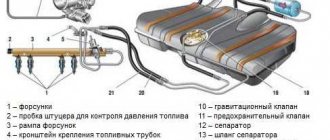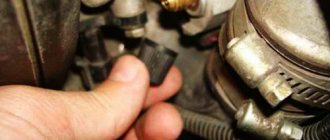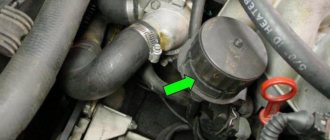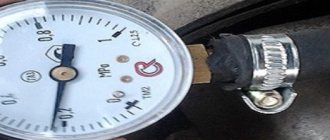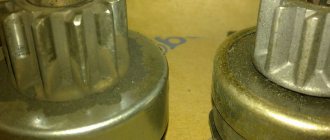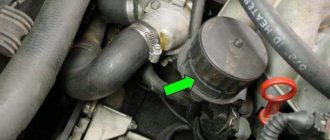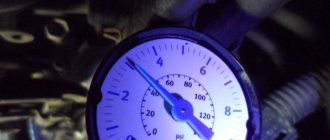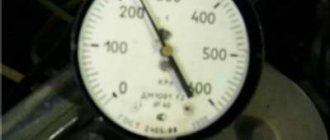For normal engine operation, timely supply of fuel at the required pressure is required. If interruptions or vibrations occur in the engine, it begins to “trouble”, very often this is due to the supply of fuel to the combustion chambers. One of the main tests that will help identify and fix the problem is measuring the pressure in the fuel rail. In the service, such diagnostics cost at least 900 rubles, but in order not to waste money and time, you can do everything yourself.
What is a fuel rail
A fuel rail is a special hollow rail through which fuel passes, being distributed through smaller diameter pipes and then through injectors before being supplied to the combustion chambers. This structural element is installed on both diesel and gasoline engines with an injector. That is, it is found in every modern engine.
The fuel rail is located on the intake manifold and is securely attached to the block. Since its operation requires high fuel pressure in the fuel system, it is made of high-quality, durable and corrosion-resistant steel. A fuel pressure regulator is also installed here, which holds it when the ignition is on but the engine is not running. This is necessary for the timely supply of fuel at startup.
Checking individual elements
When measuring the pressure in the fuel rail shows a deviation from the norm, the following reasons must be considered:
- the electric fuel pump is unable to develop the required performance;
- the regulator has failed, causing the gasoline pressure in the circuit to decrease or increase above normal;
- the fine filter is completely clogged, preventing the normal passage of fuel;
- Worn injector valves leak – the engine “floods” with fuel.
One way to check the fuel pump is to press the return hose located in the engine compartment with pliers. When the return line is blocked, the pressure gauge should show at least 5 Bar, with a new pump - 6 Bar. A pressure of 4 bar is critically low.
Since the above method does not give an absolutely accurate result and is not applicable to all car models, it is advisable to check the fuel pump by directly connecting a pressure gauge. Other elements of the system should be excluded - pipelines, fine filter and regulator. Remove the back seat of the car, get to the unit and connect the meter directly to the outlet fitting.
If the readings on the ramp and on the pump fitting are equally low, change the pumping unit. Otherwise, the problem needs to be looked for elsewhere, following the algorithm:
- Purge the fuel line and change the filter, then test again.
- Reconnect the pressure gauge to the ramp, start the engine and remove the vacuum pipe (coming from the suction manifold) from the RTD fitting. If the pressure does not change, install a new regulator.
- To make sure that the injectors are working properly, you need to measure and compare two indicators: the pressure on the manifold with the return hose pinched and the maximum pressure created by the pump when connected directly. If the second value is much higher, part of the pressure is lost at the injectors.
If you find problems with loss of pressure on the manifold itself, remove the ramp and check each injector separately. Faulty parts cannot be replaced one by one - you will have to buy and install a complete set.
The easiest way to check injectors for leakage is to test them in operation together with the manifold. Remove the ramp without disconnecting the fuel line, place a rag and turn on the ignition. If the injector valves are worn out and lose their tightness, gasoline will begin to drip from them. The working elements should be checked again - with the return hose crushed.
Source of the article: https://v-mireauto.ru/kakoe-davlenie-dolzhno-byt-v-toplivnoj-sisteme/
When is it necessary to check the fuel pressure in the rail?
There are several signs that indicate problems with the fuel system:
- Increased fuel consumption in all operating modes.
- Unstable operation at idle speed, the engine may often stall, especially after sharply pressing the gas pedal.
- All cylinders do not start - the engine “troubles”.
- Long-term starting after inactivity due to reduced pressure in the injectors.
- The intensity and toxicity of the exhaust increases.
Similar symptoms often occur with other breakdowns, but before making more complex and expensive diagnostics, it makes sense to check the fuel pressure in the rail yourself. If it is low, you need to react immediately, identifying the malfunction.
Diagnostic instructions
The first step is to free access to the ramp and fitting installed at the end of the manifold. Remove elements that interfere with measurements - air duct, filter housing, crankcase ventilation pipe, etc. (the list of parts depends on the car model). Proceed to measuring, following the instructions:
- Unscrew the protective plastic cap from the diagnostic fitting on the ramp.
- Place a cut-off plastic container and use a cap to unscrew the spool valves to release the pressure previously pumped up by the pump. You can press the valve or turn the spool 2-3 turns.
- Place one end of the gasoline hose onto the pressure gauge fitting and secure with a clamp. Unscrew the spool from the manifold, pull the second end of the hose onto the pipe.
- Turn on the ignition, and the electric fuel pump will pump fuel into the system. Make sure there are no leaks at the joints of the diagnostic tool.
- Start the engine and record the fuel pressure in the rail using the pressure gauge.
Advice. It is better to take readings from the device twice - after turning on the ignition and starting the engine. If you notice a difference, you need to additionally check the regulator and fuel pump.
The pressure level in the fuel supply circuit depends on the design of the system. In cars where the RTD and the discharge tube - “return” - are located in the engine compartment, the pressure gauge should show 2.7 Bar. The upper and lower permissible limit is 2.7–3.0 Bar. If the measured values are outside the specified range, you should continue the diagnosis and find the cause of the problem.
On many cars, including VAZ, the pressure regulator and the fuel return hose are located next to the fuel pump. The normal manifold pressure for such machines is 3.8 Bar, the maximum value is 4 Bar.
If during the measurement process periodic pressure surges within 0.2 bar are observed, the primary strainer needs to be cleaned or replaced. Typically, it is installed in the gas tank along with an electric pump.
A device for measuring pressure
The main part of the device for measuring pressure is a liquid pressure gauge with a measurement limit of no more than 8 atmospheres. It costs 300-400 rubles. Next, you will need fuel pipes of a suitable size, possibly from a VAZ, a tee, a set of clamps and quick-release fittings that can be removed on old fuel pumps.
If desired, you can buy a special kit that can be used to measure pressure in the fuel system. It works on the same principles, but will cost slightly more than a homemade assembly. Its advantage is that the set includes several sets of fittings for various fuel supply systems, and the price of the device depends on this.
Car won't start after DIY replacement
This is a fairly common problem. It must be said that the car should not start immediately after replacing the pump. The pump first needs to create operating pressure in the system. To do this, you need to turn on the ignition for a short time (a few seconds). The key must be inserted into the lock, but not turned. The lights on the dashboard should light up. Then you can rotate the engine with the starter for five to ten seconds. If nothing works out, then you should take a break for half a minute and repeat your actions.
If the engine does not start even after several cranks with the starter, this indicates that shortcomings were made during assembly and connection of the fuel pump. Another reason could be a malfunction of the new pump. There is also a possibility of a planned blocking or failure of the car’s security system.
When a car owner installs and connects a new unit, various failures may occur: sticking of valves on the pump, breakage of contacts, terminals and connectors. When such problems arise, you need to try to determine their nature. Did the breakdown occur in the mechanical or electrical part of the fuel pump? The easiest way to find out is if there is a problem with the power supply. You also need to remember that the fuel filter may become clogged.
In order to accurately determine the causes of the problems, you need to make sure that the fuel rail does not contain gasoline. After this, you need to re-remove and connect the pump directly from the battery or dimensions. This method of connecting the pump is the best for quickly checking it.
This is interesting: How to choose a mass air flow sensor
A car owner must take care of every part of the car. It is best to gain knowledge about its structure and repair yourself. It is important to acquire skills in diagnosing and solving problems in the operation of individual machine systems. This also applies to the functioning of the fuel pump.
Many drivers encounter breakdowns on the road, far from cities and service points. In such a situation, you can only rely on your own experience. Knowledge about the signs and causes of malfunctions in the fuel pump will help solve problems at the initial stage of their occurrence. It will also save effort, time and a significant part of personal funds.
Measuring process
Before starting the measurement, you need to turn off the engine and cover the place where the ramp is connected to the fitting with a rag, which will quickly absorb the gasoline that spills out when disconnected. In this case, you need to be prepared for the fact that the fuel may splash out, since it is under residual pressure.
After disconnecting the fitting, you need to insert the device into the resulting gap, after which the reliability of the connection is checked. In this case, the pressure gauge will show zero pressure - this is normal, since the tightness of the fuel line has been broken. Only then can you check the pressure in the fuel rail.
After installing the device, the ignition is turned on, the pump begins to pump fuel and the pressure gauge shows a certain pressure. In this case, the established value should not decrease, remaining stable in the region of 2.5-4 atmospheres. At the next stage, the engine starts, the pressure of the fuel pump increases by several tenths of an atmosphere, which is reflected on the pressure gauge. After stopping the engine, the pressure should return to the previous value, but not drop to zero.
If, when you disconnect the fitting before installing the device, the pipe is empty, this indicates reduced pressure, which is the first sign of problems with the fuel system. This indicates a breakdown of the pressure regulator. Another sign of failure of this unit is a drop in pressure shortly after turning on the ignition, as soon as the fuel pump stops pumping fuel into the system.
After starting the engine, the pressure can be stable, since the pressure regulator does not play any role in this case. The regulator needs to be replaced and can be done at little cost. If the engine is unstable and the pressure decreases as the speed increases, the problem is in the fuel pump.
Video: Measuring the pressure in the fuel system
Finishing the job
After the fuel has been pumped into the system, you need to turn off the ignition and make sure exactly how the pressure gauge needle will behave. So, the pressure should immediately drop to seven tenths of a bar, and be firmly established at this mark. When the pressure drops immediately to zero, this indicates a problem in the fuel pressure regulator. Most often, you have to remove and change the RTD or the check valve, which is located in the mechanism of the fuel pump motor.
Check the fuel pump filter
Try to increase the engine speed to three thousand. You need to carefully monitor the behavior of the arrow. If it starts to drop, then this means that you have problems with the fuel pump itself. But if the fuel pump is not able to create the required pressure for a long time, then this will indicate that there is a high probability that the fuel filter was clogged with foreign objects. In particular, you need to check the mesh of this filter. If necessary, it must be replaced with a new one.
If necessary, replace the entire fuel pump (pictured Lifan Breeze)
If all the above tips did not help you, then this means that you need to carry out more serious measurements, including diagnosing the idle air control, compression in the cylinders, and so on. It is worth working with such elements of a car only when you know exactly what you are doing. Otherwise, it is appropriate to contact specialized automobile workshops.
What are the causes of pressure drop in the fuel system?
A drop in fuel pressure in the system is one of the signs that its components are failing. After this, additional diagnostics will be required to help identify the problem and replace the part. The main reasons for the drop in pressure in the fuel line:
- damage or wear of the fuel hose or rubber seals;
- nozzles do not hold;
- the fuel pump is worn out;
- pressure regulator failure.
Despite certain discomfort, for example, the car will start up worse, accelerate less, or smoke during operation, it will still be possible to drive it. But the fuel pump will already work in extreme conditions, since the sensors will require to maintain the nominal pressure and will wear out faster. As a result, it will fail. If the problem is identified in a timely manner, you can limit yourself to simply replacing the pipe, seal and fuel pressure regulator.
Thus, by making a simple device with your own hands, you can significantly extend the service life of the fuel pump and injectors, promptly identifying problems that lead to a drop in pressure in the fuel system. This will significantly reduce the cost of operating the car.
Seal
Recommendations for selection
In order to be able to periodically and as necessary monitor the operation of the fuel system and its condition, you cannot do without pressure gauges for measuring fuel pressure. It is enough for a motorist to have one such device at his disposal. You just need to determine in advance which one is needed and which one is suitable for completing the planned tasks. To ensure that the pressure gauge for checking the pressure in the fuel supply system gives accurate measurement parameters, it is recommended to choose a high-quality device. If you contact the sellers, you will find a huge variety of models and manufacturers. But the main role will be played by the design and technical characteristics of the device. All of them are divided into 2 large groups.
- Analog. They're mechanical. Presented in the form of an arrow and a measuring scale. With their help, the user sees what pressure is currently in the fuel rail. The design of analog devices is as simple as possible, which gives such an obvious advantage as reliability. If you correctly understand the nuances of the application, the displayed parameters will correspond as closely as possible to the actual pressure in the system, that is, the error will be insignificant. But mechanical devices have one drawback. This is a fairly large error range. It is especially pronounced when it is in the hands of an inexperienced motorist. But the demand for analog pressure gauges is still high. This can largely be explained by the low cost.
- Digital. An alternative to mechanical meters and a more modern version of a pressure gauge is a digital device. It is characterized by more accurate results, as well as minimal error. For such pleasure you will have to pay a little more than for the analog version. All measurement data is displayed on the display. At the same time, the user has the opportunity to choose between different units of measurement, which makes the digital device more functional and versatile. The accuracy of the measurement directly depends on the accuracy class. Here it is important to wisely choose a device that is suitable specifically for measuring pressure in an automobile fuel rail.
Some actively use a tire pressure gauge, that is, a device designed to monitor the pressure in the tires of a vehicle. There is nothing surprising here, since devices for measuring tire, oil and fuel pressure operate on an identical principle. But there are certain features that you should definitely be aware of before buying such a supposedly multifunctional device. To measure the pressure in the fuel system rail of a car, the limit values should be at the level of 5-7 atmospheres. If air pressure is measured, then the interval varies from 16 to 20 units. If you take an air pressure gauge and connect it to the fuel rail, the error will be very high. The device will not be able to show the correct parameters. But even tenths play a role here.
When choosing an analog-type measuring device, be sure to make sure that the proposed scale will be convenient for reading information. Sometimes the font is very small, or the scale is divided in a way that is not entirely clear and easy to read. In this case, the measurement limit should be 5-6 atm. If you have decided on the model, then finally check the tightness of all connections. This is extremely important because you will be working with fuel. As for digital devices, everyone decides for themselves whether they are worth buying or not. Their cost is noticeably higher than mechanical or analog pressure gauges. And such costs are not always justified. If your financial condition allows it, and you don’t mind spending this money on a pressure gauge, feel free to buy it. Moreover, it is better to choose devices from famous brands with a high level of accuracy.
Sources
- https://LifanoVod.ru/kak-izmerit-davlenie-v-toplivnoj-rampe-kogda-neobxodimo-ego-proveryat/
- https://diagnozbibike.ru/kak-proverit-benzonasos/
- https://autobann.su/kak-proverit-davlenie-v-toplivnoi-rampe.html
- https://www.autoscaners.ru/catalogue/?catalogue_id=testers_fuel_pressure
- https://zen.yandex.ru/media/id/5beafefd84edee00aa843c51/kak-samostoiatelno-izmerit-davlenie-v-toplivnoi-rampe-avtomobilia-i-zachem-eto-nujno—5c195ae994ee4e00aadf0242
- https://studiofiring.ru/heating-system/check-of-pressure-in-a-fuel-stage-on-cars-of-vases-and-a-fret-with-an-injector-engine/
- https://avto-idea.ru/remont/kak-proverit-toplivnyy-nasos-v-avtomobile-svoimi-rukami/
- https://DriverTip.ru/zhizn/kak-vybrat-izgotovit-manometr-davleniya-topliva.html
[collapse]
What devices are used
Converted tire pressure gauge
Several instruments can serve as devices for taking pressure readings.
- A special device purchased from an auto parts store. It comes complete with an adapter, drain hose and pressure gauge. Costs about 1.5 thousand rubles.
- Converted tire pressure gauge. The instrument scale and tube are subject to modification. As you know, the air pressure gauge shows a value of up to 20 atm, and the fuel measurement limit is around 5-7 atm. For this reason, reading errors may occur, and the device is modified to take this into account. Regarding the tube: you need to change it to a gas-resistant version.
Injection pump pressure on a Mercedes
This is a high pressure pump installed on diesel cars and some gasoline cars.
This is how pressure is measured.
- Motor 4g93 starts.
- Take a multimeter, which is connected with one probe to the middle connector of the RTD chip. The second probe must be connected to the negative terminal of the battery.
- Indicators are taken.
The normal value should vary within 3 volts. If it is less, you need to raise the speed of the power plant and keep it within 2000 rpm. Adjust the pressure bolt in this mode by rotating clockwise. At the same time, you need to look at the device to stop rotation as soon as the pressure reaches the standard value of 3 volts.
If the pressure does not want to return to place, you can draw conclusions about a fuel leak or a malfunction of the fuel system elements, including the pump.
What should be the pump pressure on a VAZ
The pressure created by the electric pump should vary within 5-7 atm. As a rule, the fuel pump is tested “into the wall”. In other words, the net pressure developed by the fuel pump is measured.
- As a rule, if the readings are in the region of three atm, this is evidence of problems with the engine of the car, which cannot keep up with the powerful fuel supercharger and is “stupid.”
- If the pressure is in the four atm zone, it’s time to change the pump, although it may last for several tens of thousands of kilometers.
- The condition of a working pump should be within five or seven atm.
Measuring devices
To check the pressure of the fuel pump with your own hands, you need to prepare a set of simple devices:
- a pressure gauge designed for a maximum pressure of 10 Bar (1 MPa), a suitable device for checking tires;
- gasoline hose with an internal diameter of 8 mm;
- a cap for unscrewing spool valves from wheel valves;
- clamping clamps 10–15 mm – 2 pcs.
To take measurements at other points in the fuel supply circuit, you will need homemade adapters to connect a gasoline hose with a pressure gauge. If the line is assembled with quick-release plastic connections, you need to buy one such clamp with a fitting. To connect to a threaded joint, purchase the appropriate tube with nuts and cut it into 2 parts. From tools and accessories you will need:
- pliers;
- screwdriver;
- cut plastic bottle of small capacity (up to 1 liter);
- rags.
Connecting the pressure gauge and measuring the gasoline rail is carried out in any convenient place - an open area, a garage or on an overpass. If you need to check the fuel pump itself, you need to prepare a standard set of tools for disassembling the unit located under the rear seat of the car. To replace the fine fuel filter, the car will have to be driven into an inspection ditch.
